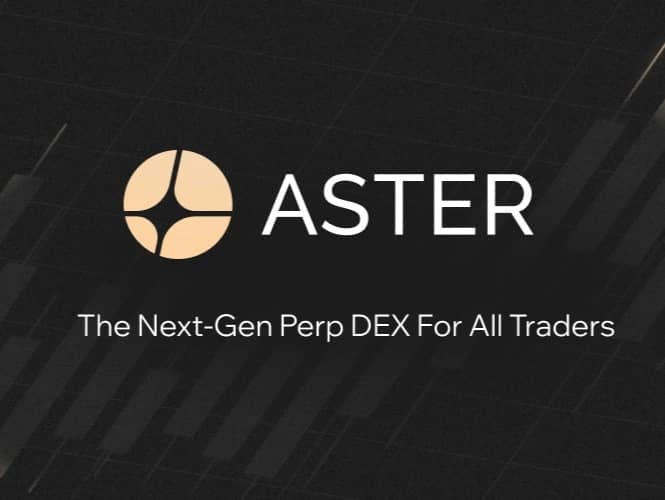订阅 wiki
Share wiki
Bookmark
Aster
Aster
Aster 是一个去中心化永续交易所,旨在促进跨多个区块链网络的永续合约的非托管交易。它旨在通过聚合来自各个链的流动性来提供统一的交易体验。 [1] [2]
概述
Aster 是在 2024 年底由多资产流动性中心 Astherus 和去中心化永续协议 APX Finance 合并后成立的。此次合并旨在将 Astherus 的 收益 生成产品与 APX Finance 的永续交易基础设施相结合。该平台专注于去中心化永续和现货交易作为其核心产品,以非托管模式运营,用户保留对其资产的控制权。该项目获得了 赵长鹏 和 CZ 关联的 YZi Labs 的大力支持。 [17] [18]
该平台聚合来自多个 区块链 的流动性,使用户无需手动桥接资产或切换网络即可进行交易。它提供两种不同的交易界面:简易模式,用于简化的、一键式交易;专业模式,适用于需要详细图表、订单簿和复杂工具的高级交易者。截至 2025 年 9 月,Aster 报告的累计统计数据包括超过 5140 亿美元的总交易量、200 万用户、2.54 亿美元的未平仓合约和 3.74 亿美元的 总锁定价值 (TVL)。 [19]
Aster 将自己定位在数十亿美元的去中心化永续交易市场中,旨在与 Hyperliquid 等已建立的平台竞争。从 Astherus 到 Aster 的品牌重塑标志着战略重点是成为一个著名的 去中心化永续交易所。Aster 的核心贡献者 Dust 表示,“品牌重塑是我们引领 DeFi 永续合约市场的雄心壮志的核心。我们对永续交易的战略重点也将确保 Aster 的长期可持续性”。 [1] [2] [3] [3] [4]
历史
Aster 的起源可以追溯到 Astherus 和 APX Finance 的独立运营。Astherus 以其收益生成产品而闻名,而 APX Finance 则专注于去中心化永续交易基础设施。在 2024 年末,这两个协议进行了合并。这次合并导致了品牌重塑,并在 2025 年 3 月 31 日以 Aster 的名称推出了统一平台。
在品牌重塑之前,Astherus 和 APX Finance 已经累计处理了超过 2580 亿美元的去中心化永续交易量。在公开品牌重塑之前,完成了一轮涉及 YZi Labs(前身为 Binance Labs)的战略融资。 [2] [3] [5] [5]
ASTER 代币发布
2025年9月17日,Aster发布了其原生代币ASTER。此次发布引起了市场的极大兴趣,该代币的市值在六小时内超过了3亿美元。价格从0.08美元的发行价上涨到第一天的最高价0.2181美元,为早期投资者带来了超过130%的收益。代币的现货交易对ASTER/USDT在发布后不久便在Aster自己的现货交易所上线。 [17] [20] [22]
技术
Aster 的技术核心是促进去中心化永续合约交易,重点在于多链兼容性和用户体验。一个核心功能是其跨链流动性聚合,旨在通过从多个区块链网络提取流动性来提供深度流动性。这种聚合旨在允许用户进行交易,而无需手动在链之间桥接资产。该平台计划支持 BNB 链、以太坊、Solana 和 Arbitrum。 [17] [18]
该平台提供两种主要的交易模式:
- 简易模式: 专为易用性而设计,提供高达 1001 倍杠杆的一键交易。此模式被描述为抗 MEV,适合喜欢简化界面而无需详细图表的用户。它可在 BNB 链 和 Arbitrum 等网络上使用。 [1] [4]
- 专业模式: 提供订单簿界面,具有高级交易工具、实时数据和各种订单类型,适合经验丰富的交易者。此模式还具有旨在降低 MEV 风险的工具,例如隐藏订单,这些订单使订单大小和方向不会公开可见。CZ Zhao 强调了此功能,认为它是解决其他链上 DEX 上出现的清算操纵的方案。专业模式可在包括 BNB 链、以太坊 和 Solana 在内的网络上使用。 [1] [2] [17]
Aster 上的交易自动执行,处理跨聚合流动性来源的过程。该平台利用智能合约进行运营。路线图中概述的未来技术发展包括集成零知识证明以增强隐私,开发专用的 Layer 1 区块链(Aster 链)以优化交易,以及旨在自动化跨链和流动性来源的交易执行的基于意图的系统。Aster 链的 Beta 版本于 2025 年 6 月为选定的交易者推出。 [1] [2] [3] [4] [6] [1] [1]
产品与功能
Aster 提供一系列用于现货和衍生品交易的产品,以及产生收益的机会。
交易
Aster Earn
除了永续交易之外,Aster 还整合了从 Astherus 继承的收益生成产品,这些产品位于 Aster Earn 部分下。这些产品允许用户质押各种资产以赚取收益。支持质押的资产包括 BNB、USDT、BTC 和 CAKE。特定的收益产品包括 BNB 流动性质押衍生品 asBNB、asCAKE、asBTC 以及生息稳定币 USDF (asUSDF)。这些资产也可以用作抵押品,平台声称这可以释放更高的资本效率。 [7] [8] [3] [7] [9] [10] [11] [12] [18]
Aster 还具有 Aster ALP(Aster 流动性池),允许用户通过存入 USDT、BNB 等资产来铸造池代币,从而赚取被动收益。 [11]
该平台包括一个推荐计划,提供推荐交易活动的佣金。API 可供开发人员和高级用户使用。 [13] [2]
USDF 稳定币
USDF 是一种收益型稳定币,在 Aster 生态系统中的 Aster Earn 产品下得到支持。用户可以通过存入支持的资产来铸造 USDF。该稳定币旨在维持价格稳定,并为持有者提供收益。 [12] [14] [12] [12]
ASTER 代币
Aster 生态系统的原生实用和治理代币是 ASTER。它于 2025 年 9 月 17 日在 BNB 链上启动。 [17] [21]
代币经济学
ASTER的总供应量和最大供应量为80亿个代币。启动时,初始流通供应量约为16.56亿个ASTER。该代币旨在分散治理、推动平台增长、奖励用户参与并确保持续的长期发展。代币分配包括空投(53.5%)、生态系统和社区(30%)、国库(7%)、团队(5%)以及流动性/上市(4.5%)等几个类别。 [18] [21] [23]
空投和分配
作为其启动策略的一部分,Aster进行了大规模的社区空投,空投了7.04亿个ASTER代币,占总供应量的8.8%。空投分发给参与平台预启动“Genesis”和“Spectra”积分活动的用户。这些活动产生了显著的预启动活动,积累了数十万个钱包和超过5140亿美元的交易量。空投的领取期于2025年9月17日开始,计划持续30天。分发的代币受归属时间表限制:25%的分配在代币生成事件(TGE)时可用,随后是三个月的悬崖期,以及随后九个月的线性归属期。30天窗口期后未领取的任何代币将被指定返回社区奖励池,以供未来分配。 [17] [23]
APX 代币升级
为了配合 ASTER 的发布,项目启动了 APX 代币的退役计划,APX 代币是合并前 APX Finance 协议的原生代币。代币兑换计划于 2025 年 9 月 17 日开始,允许 APX 持有者将其代币兑换为 ASTER。兑换最初以 1:1 的比例开始,该比例设计为先到先得,随着时间的推移而降低,以鼓励早期转换。APX DAO 的质押者也被允许解锁他们质押的代币,而无需受到惩罚,以参与兑换。此次代币升级是通过 ASTER 代币分配的生态系统和社区部分来实现的。 [24] [23]
支持与反响
Aster 在推出时获得了加密行业知名人士和实体的大力支持,这为其强大的初始市场接受度做出了贡献。
CZ 币安和 YZi Labs
该项目得到了赵长鹏(CZ)和 YZi Labs(更名为 币安 实验室)的显著支持。CZ 的公开支持是该项目知名度的重要因素。他曾在社交媒体上发布了 ASTER 的价格图表,这与他通常发布的关于 BNB 或比特币的内容不同,并评论说 Aster 团队“出色地执行了发布”。他还曾对一个将 Aster 的订单簿与主要交易所进行比较的帖子做出回应,称“Aster 上的流动性达到币安水平”。这种认可,加上 YZi Labs 的官方支持,为该项目提供了实质性的可信度。 [17] [22]
市场反响
由于其著名的支持者和发布前的势头,ASTER的推出受到了市场的强烈积极反响。该平台报告了基于其发布前活动的快速用户增长。代币推出后,一些加密货币分析师开始将ASTER称为“中国版Hyperliquid”,预测其具有巨大的增长潜力。这些分析师指出,CZ支持的其他项目(如MYX Finance)取得了成功的记录,该项目上涨了1000%。一些预测表明ASTER将上涨10倍,这将使其完全稀释估值(FDV)达到150亿美元,仍然只是当时Hyperliquid估值的一小部分。CZ在BNB等项目上的成功记录也增强了这种市场情绪,BNB从最初的发行价大幅上涨。 [17] [22]
合作伙伴关系
Aster已在去中心化金融生态系统中建立了合作伙伴关系。列出的著名合作伙伴包括YZi Labs、Pendle、ListaDAO、Kernel、Venus、YieldNest和PancakeSwap。YZi Labs(前币安实验室)被认为是该项目的关键支持者。该平台与Pendle和PancakeSwap等协议集成,用于收益策略和流动性提供。 [16] [16] [1] [3] [15] [19]
里程碑和事件
发现错误了吗?
